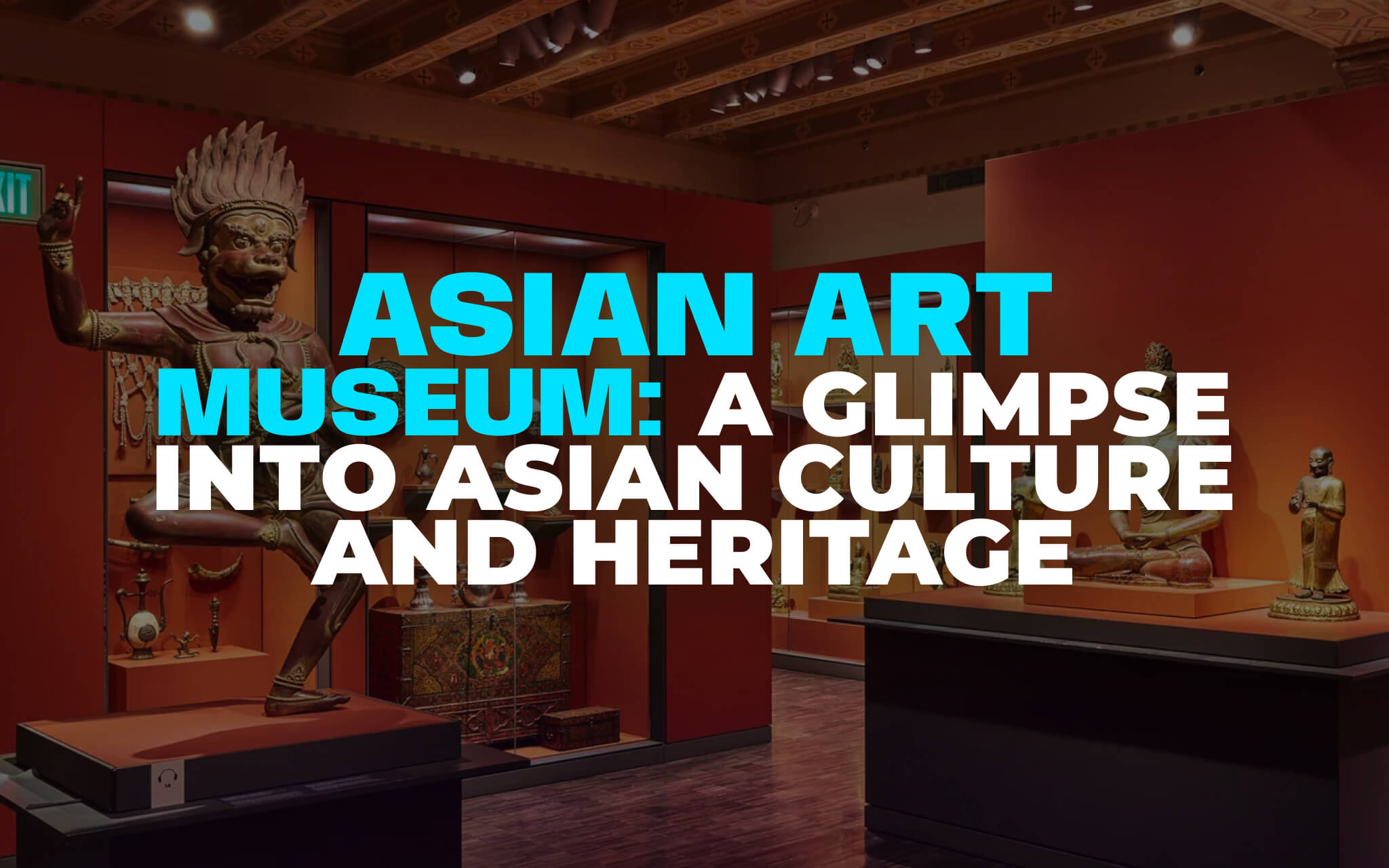
Inside the Halls: A Treasure Trove of Asian Art
Setting the Standard: National and International Recognition
Interactive Exhibits: Engaging the Next Generation
Visitor Essentials: Tips for a Perfect Visit
Diverse Attractions in the Vicinity: Museum of 3D Illusions
A Lasting Impression: The Museum’s Impact on SF’s Art Scene
San Francisco is renowned for its rich tapestry of cultures, and amongst them, the luminous thread of Asian heritage shines brightly. The city, with its historical ties to Asia, has always embraced the vibrant diversity of Asian cultures. The Asian Art Museum, a testament to this rich heritage, is not just a gallery but a living embodiment of the deep-rooted Asian influences shaping the city’s cultural mosaic.
Centrally located in San Francisco, the Asian Art Museum stands as a beacon of cultural enlightenment, drawing visitors from around the globe. Every corner of this museum tells a story, from ancient civilizations to the modern dynasties of Asia. It’s a place where history comes alive, where the past mingles with the present, offering insights into the diverse Asian communities that have thrived in San Francisco.
The museum plays a crucial role in education and awareness. It’s not just about artifacts and relics; it’s about understanding the essence of Asian culture, its values, traditions, and its evolution over time. The narratives spun within the walls of the Asian Art Museum resonate deeply with both the Asian diaspora and those intrigued by Asian art and history.
Location and Architecture: A Blend of Tradition and Modernity
In the heart of San Francisco, the Asian Art Museum emerges as an architectural marvel. Reflecting a confluence of traditional Asian design elements with modern aesthetics, it stands as a symbol of how the past can beautifully integrate with the present. The grand façade and the intricately designed interiors create a serene environment, perfect for introspection and appreciation of art.
The museum’s location is strategic, making it accessible to locals and tourists alike. Nestled amidst San Francisco’s bustling cityscape, it offers a peaceful retreat to those seeking a deep dive into Asian culture. The surroundings, with its verdant greenery and urban design, compliment the museum’s intent, making it a significant landmark in the SF art scene.
Inside the Halls: A Treasure Trove of Asian Art
Stepping inside, one is immediately transported across diverse Asian landscapes, from the vast deserts of Mongolia to the tropical forests of Southeast Asia. The gallery houses an extensive collection of artifacts, each piece narrating a unique story of its origin, the hands that crafted it, and the culture it represents.
The vast collection spans multiple countries and centuries. Ancient sculptures, traditional paintings, and modern art pieces coexist harmoniously, offering visitors a comprehensive view of Asia’s artistic journey. Special exhibitions often grace the gallery, showcasing specific themes or artists, further enriching the museum’s already extensive collection.
Setting the Standard: National and International Recognition
Nationally and globally, the Asian Art Museum is recognized as a premier institution for its extensive collection of Asian artworks. Its exhibitions have drawn international attention, attracting art connoisseurs, national historians, and enthusiasts from every corner of the world. Such global acclaim has cemented its position not just on the national stage but in the international art arena as well.
Collaborations with other renowned museums across the globe have further elevated its status. These partnerships have enabled the exchange of artifacts, research, and exhibitions, ensuring that the museum remains at the forefront of national Asian art curation. Such collaborations are a testament to the museum’s commitment to promoting Asian art on a national and global scale.
Interactive Exhibits: Engaging the Next Generation
To ensure the legacy of Asian art and culture endures, the museum has invested heavily in creating interactive exhibits designed to captivate younger minds. These areas, often bustling with school groups and families, offer hands-on experiences, making learning engaging and fun. By introducing children to Asian art in such immersive ways, the museum sows the seeds of appreciation early on.
Technology plays a significant role in these interactive zones. Augmented reality, touch-sensitive displays, and multimedia installations make ancient art relatable to the tech-savvy younger generation. These innovations have transformed traditional museum visits into dynamic learning experiences, bridging the gap between the past and the present.
Visitor Essentials: Tips for a Perfect Visit
For those planning a visit, there are several things to keep in mind to enhance the experience. The gallery’s layout is expansive, so it’s advisable to allocate ample time to explore at a leisurely pace. Maps, available at the entrance, offer a guided path, ensuring that visitors don’t miss out on any significant exhibit.
While this SF museum is a treat at any time of the year, there are peak times during special exhibitions or events that draw larger crowds. It’s always a good idea to check the museum’s calendar in advance and plan visits accordingly. This ensures a more serene and personal experience, allowing for deeper engagement with the art.
For frequent visitors or those deeply invested in Asian art and culture, the museum offers membership options. These memberships provide numerous benefits, from early access to new exhibitions to discounts at the museum store. Being a member not only offers value but also allows individuals to become part of a community that cherishes and promotes Asian art.
Diverse Attractions in the Vicinity: Museum of 3D Illusions
After an enriching experience at the Asian Art Museum, visitors can extend their journey into the realm of art at the nearby Museum of 3D Illusions. This museum, while different in content, offers a unique blend of art and technology. Visitors can immerse themselves in stunning 3D displays, each carefully crafted to deceive the eye and boggle the mind.
Interactive art installations encourage visitors to become part of the artwork. From seemingly floating on air to being chased by fictional creatures, the Museum of 3D Illusions promises a plethora of photo opportunities. Each room is a canvas where reality blends with illusion, offering a stark contrast to the historical depths of the Asian Art Museum.
Adjacent to the Museum of 3D Illusions is another unique attraction, “Smash It!”, which offers an unconventional art experience. Visitors can unleash their creativity by decorating plates, vases, and more, and then experience the cathartic release of smashing their creations. It’s a quirky, fun experience, balancing the contemplative nature of a museum visit with unabashed fun.
A Lasting Impression: The Museum’s Impact on SF’s Art Scene
The Asian Art Museum has undeniably etched itself into the fabric of San Francisco’s art scene. Its vast collection, combined with its educational initiatives and community programs, ensures that it remains a pivotal institution in our national cultural landscape. Through its endeavors, the museum not only showcases art but also the narratives, histories, and values embedded within.
The Asian Art Museum is more than just a repository of artifacts. It’s a living, breathing entity that embodies the spirit of Asia in the heart of San Francisco. Through its halls, exhibitions, and programs, it continues to inspire, educate, and captivate, leaving an indelible mark on all who walk its corridors.
FAQ
Is the Museum of 3D Illusions near the Asian Art Museum?
Yes, after exploring the Asian Art Museum in San Francisco, art enthusiasts can extend their experience by visiting the nearby Museum of 3D Illusions. Both venues offer unique perspectives on art, with one focusing on traditional Asian art and the other on modern 3D interactive displays.
What makes the Asian Art Museum a notable attraction in San Francisco?
The Asian Art Museum stands out in San Francisco's art scene due to its extensive collection of Asian artifacts spanning multiple countries and centuries. Its blend of traditional and modern art, coupled with its influential role in the national art community, makes it a must-visit destination.


